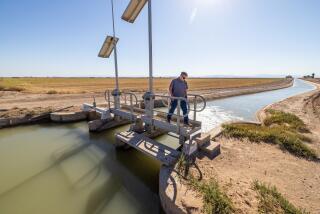Markham Salsbury, 98; Led Flood Control Efforts
- Share via
Markham E. “Ham” Salsbury, who took a county job he was told “couldn’t last more than two years” but stayed on for 38 supervising creation of the Los Angeles Basin’s $1-billion flood control and water conservation system, has died. He was 98.
Salsbury, who retired in 1965 as chief engineer of the Los Angeles County Flood Control District, died March 20 in a Rancho Palos Verdes retirement community of complications associated with aging.
After graduating from Caltech with a civil engineering degree in 1925, Salsbury joined the Los Angeles County Surveyor’s Office. But two years later, he switched to the Flood Control District for what he thought would be a brief tenure in a better-paying job.
“In those days when times were hard, young people didn’t think in terms of greater opportunity, job satisfaction and advancing their careers,” he told The Times in 1965.
But he had stepped into the neophyte Flood Control District--created in 1915 after a disastrous flood and folded into the Public Works Department in the mid-1980s--at a propitious time. Officials were beginning to consider comprehensive basinwide planning and engineering to solve a large-scale problem, rather than get by on stopgap city-by-city measures.
“There was no such thing as a long-range plan for flood control or water conservation. We were operating on a 2- or 3-cent property tax levy then and the Board of Supervisors frankly wasn’t too aware of our need in 1927,” he said.
More county funds, or a bond issue, came the department’s way only after a wet winter washed away homes and perhaps drowned a few people, he said.
But from 1927 to 1965, with Salsbury as assistant chief engineer or chief engineer, the district worked with the basin’s many cities and the U.S. Army Corps of Engineers to spend $1 billion constructing 14 dams, 55 debris basins and 263 miles of permanent concrete channeling and additional storm drains. In those years, the district staff grew from 200 to 1,200.
Millions of Gallons of Water Conserved
Salsbury played a key role in the conception and construction of the system, former county spokesman Stan Steenbock said. He said the project conserved millions of gallons of water annually, added coastline barriers to prevent saltwater contamination of fresh water and curbed flooding.
When he left office, Salsbury estimated the project was 75% complete.
The massive effort largely changed the basin from an agricultural area to one of highly urbanized communities, enabling increases in construction of housing and commercial facilities to accommodate increasing numbers of people.
As head of the largest local agency of its kind, Salsbury was in demand as a speaker at national water resources conferences of the American Society of Civil Engineers and other groups.
He dealt with issues particular to his era--such as testifying before the Board of Supervisors on which storm drains could be used as fallout shelters in case an atomic bomb was dropped on Los Angeles.
But he also dealt with ongoing issues including burgeoning growth. Part of the problem, he said in 1965 with implications still pertinent today, “is that people insist on living in places they shouldn’t.”
After retiring from his flood control position, Salsbury served as chairman of the Watershed Fire Council of Southern California, working for funds to reduce fire danger in the area’s four national forests--Cleveland, San Bernardino, Angeles and Los Padres.
Information about any survivors was unavailable.
Steenbock said memorial donations could be sent to the Caltech YMCA, in care of Molly Hood, Mail Code 158-86, Pasadena, CA 91125.
More to Read
Sign up for Essential California
The most important California stories and recommendations in your inbox every morning.
You may occasionally receive promotional content from the Los Angeles Times.









